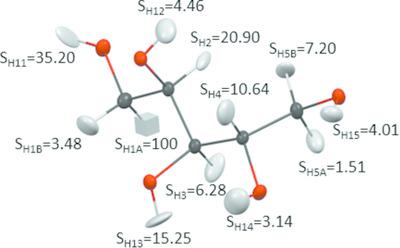当前位置:
X-MOL 学术
›
Acta Cryst. B
›
论文详情
Our official English website, www.x-mol.net, welcomes your
feedback! (Note: you will need to create a separate account there.)
HAR, TAAM and BODD refinements of model crystal structures using Cu Kα and Mo Kα X‐ray diffraction data
Acta Crystallographica Section B ( IF 1.3 ) Pub Date : 2021-01-25 , DOI: 10.1107/s2052520620014936 Monika Wanat , Maura Malinska , Matthias J. Gutmann , Richard I. Cooper , Krzysztof Wozniak
Acta Crystallographica Section B ( IF 1.3 ) Pub Date : 2021-01-25 , DOI: 10.1107/s2052520620014936 Monika Wanat , Maura Malinska , Matthias J. Gutmann , Richard I. Cooper , Krzysztof Wozniak

|
The Independent Atom Model (IAM) of electron density is used in routine X‐ray data analysis. However, this model does not give a quantitative description of the electron‐density distribution. A better model that allows for modelling of aspherical charge density deformations is introduced by the Hansen–Coppens variant of the multipole model of electron density. However, the application of this model requires crystals of excellent quality and high‐resolution XRD data which are quite often difficult criteria to fulfil. Therefore, Mo Kα and Cu Kα data of three model compounds (tricyclic imide, xylitol and methyluracil) were refined using IAM and new methods which enabled the refinement and reconstruction of charge density based on the Cu Kα data. These methods were the Bond‐Oriented Deformation Density (BODD) model, Hirshfeld Atom Refinement (HAR) and the Transferable Aspherical Atom Model (TAAM). The final results were compared to the model obtained from neutron diffraction experiments. Our results demonstrated not only that Cu Kα data may be refined using BODD, HAR and TAAM methods, but also revealed systematic errors arising from the use of Cu Kα data. These errors were a result of the limited information in the low‐resolution data set that manifested as higher values for the anisotropic displacement parameters (ADPs) and smaller maxima and minima of the residual electron density for the Cu Kα data compared to the Mo Kα data. Notably, these systematic errors were much less significant than those found for the IAM. Therefore, the application of BODD, HAR and TAAM on Cu Kα data has a more significant influence on the final results of refinement than for the Mo Kα data.
中文翻译:

利用CuKα和MoKαX射线衍射数据对模型晶体结构进行HAR,TAAM和BODD精修
电子密度的独立原子模型(IAM)用于常规X射线数据分析。但是,该模型没有给出电子密度分布的定量描述。电子密度多极模型的Hansen–Coppens变体引入了一个更好的模型,该模型可以对非球面电荷密度变形进行建模。但是,该模型的应用需要具有优良品质和高分辨率XRD数据的晶体,这些晶体通常很难满足。因此,使用IAM精制了三种模型化合物(三环酰亚胺,木糖醇和甲基尿嘧啶)的Mo Kα和Cu Kα数据,并且新方法能够基于Cu K细化和重建电荷密度 α数据。这些方法是面向键的变形密度(BODD)模型,Hirshfeld原子细化(HAR)和可转移非球面原子模型(TAAM)。将最终结果与从中子衍射实验获得的模型进行比较。我们的结果表明,不仅可以使用BODD,HAR和TAAM方法完善Cu Kα数据,而且还揭示了因使用Cu Kα数据而引起的系统误差 。这些错误是由于低分辨率数据集中信息有限而导致的,结果表明,与Mo K相比,各向异性位移参数(ADP)的值较高,而Cu Kα数据 的剩余电子密度的最大值和最小值较小。 α数据。值得注意的是,这些系统性错误远不如IAM发现的那些重要。因此,与Mo Kα数据相比,将BODD,HAR和TAAM应用于Cu Kα数据对精炼最终结果的影响更大 。
更新日期:2021-02-09
中文翻译:

利用CuKα和MoKαX射线衍射数据对模型晶体结构进行HAR,TAAM和BODD精修
电子密度的独立原子模型(IAM)用于常规X射线数据分析。但是,该模型没有给出电子密度分布的定量描述。电子密度多极模型的Hansen–Coppens变体引入了一个更好的模型,该模型可以对非球面电荷密度变形进行建模。但是,该模型的应用需要具有优良品质和高分辨率XRD数据的晶体,这些晶体通常很难满足。因此,使用IAM精制了三种模型化合物(三环酰亚胺,木糖醇和甲基尿嘧啶)的Mo Kα和Cu Kα数据,并且新方法能够基于Cu K细化和重建电荷密度 α数据。这些方法是面向键的变形密度(BODD)模型,Hirshfeld原子细化(HAR)和可转移非球面原子模型(TAAM)。将最终结果与从中子衍射实验获得的模型进行比较。我们的结果表明,不仅可以使用BODD,HAR和TAAM方法完善Cu Kα数据,而且还揭示了因使用Cu Kα数据而引起的系统误差 。这些错误是由于低分辨率数据集中信息有限而导致的,结果表明,与Mo K相比,各向异性位移参数(ADP)的值较高,而Cu Kα数据 的剩余电子密度的最大值和最小值较小。 α数据。值得注意的是,这些系统性错误远不如IAM发现的那些重要。因此,与Mo Kα数据相比,将BODD,HAR和TAAM应用于Cu Kα数据对精炼最终结果的影响更大 。









































 京公网安备 11010802027423号
京公网安备 11010802027423号